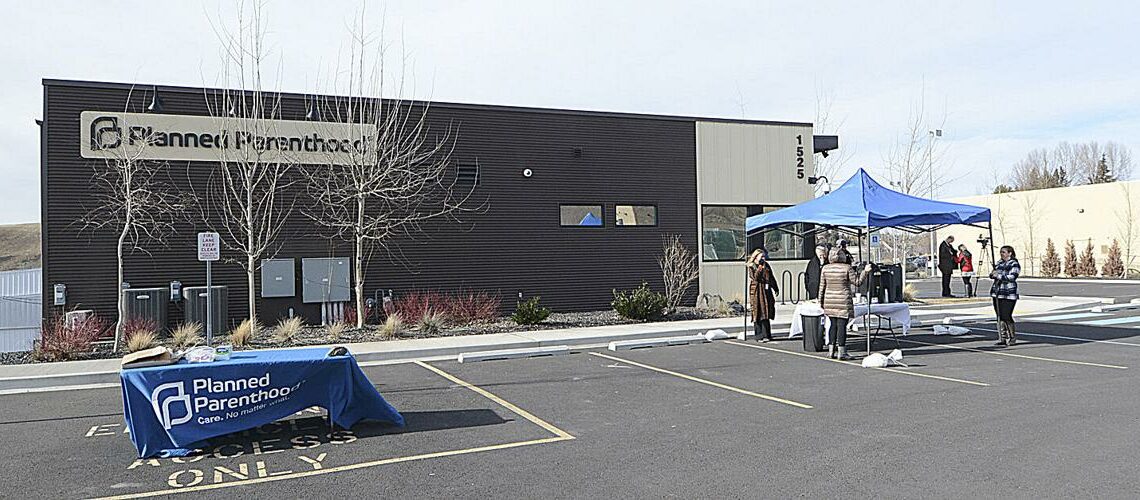
Two years post-Dobbs, no state is left unaffected
Listen
(Runtime 0:54)
Read
A report compiled by U.S. Sen. Maria Cantwell’s office shows that in the two years since the decision in the Dobbs v. Jackson Women’s Health Organization case, which repealed federal abortion protections, states where abortion is legal saw skyrocketing demand from out-of-state patients.
According to the report, in Washington state, abortion patients presented on average of a week later for care after abortion bans went into effect. The state saw a 50% increase in out-of-state patients.
The increased wait times pushed some Washington residents out of state to seek quicker care, with Oregon Health & Science University seeing a 20% increase in abortion patients from Washington state, according to the report. The hospital’s total abortion volume roughly doubled over the past two years.
Planned Parenthood Columbia Willamette also opened a new clinic specifically to meet the demand of Idaho patients seeking care that’s now illegal in their home state.
Abortion funds that provide financial and practical assistance to people seeking abortions reported major increases in requests for assistance from out-of-state clients.
People of color and low-income patients were most heavily affected by abortion bans, according to data from the Guttmacher Institute, and for some who received assistance, traveling for their abortion was their first time flying in an airplane or leaving their home state.
“We support many people who have never flown in an airplane before. And so when we have to book flights, that’s not only a very expensive option, but it can be really hard and confusing,” said Alison Dreith, director of strategic partnerships at the Midwest Access Fund, in an interview with Cantwell’s staff.
The report also showed the longest wait times at abortion clinics were in cities with numerous direct flight options from states with abortion bans.
Data compiled in the report showed that abortion bans were severely limiting safe miscarriage care in states with abortion bans.
STAT News did an analysis of Texas, which has a similar near-total abortion ban as Idaho. The analysis showed there were just 34 legal abortions reported during a six-month period in 2023. Researchers estimated the number of women needing abortions in Texas is at least 400 per year for life-ending emergencies and 2,400 per year for physical health risks.
In Idaho, doctors have continually pushed for a maternal health exception that goes beyond the current law’s existing exception “to save the life of the mother.”
Often, the standard of care for miscarriage is the same procedure as an abortion. But doctors say patients aren’t always aware of that fact.
“People don’t understand that when you ban abortion, you ban miscarriage care as well,” said Bré Thomas, in an interview with Cantwell’s staff. Thomas is the CEO of the reproductive health nonprofit Affirm AZ.
In states like Idaho that severely restricted abortion, hospitals have continually struggled to recruit providers and residents.
Dr. Robyn Hitchcock, an emergency doctor in Colville, Washington, terminated her privileges at a small Idaho hospital following the state’s implementation of its abortion laws.
“A mom can bleed to death from an incomplete miscarriage,” Hitchcock said in an interview with Cantwell’s staff. “In Washington, I can complete that miscarriage and stop her bleeding. But if I am in Idaho and I do that same thing, I worry that I could go to jail for saving that person’s life.”
In addition to abortion care and maternal fetal health, the Dobbs decision has impacted health care providers’ willingness to practice in certain states.
Since Dobbs, 22% of Idaho’s OB-GYNs have left the state, according to a report by the Idaho Coalition for Safe Healthcare. According to Cantwell’s report, over 17% of OB-GYN residents in a 2023 survey said the reversal of abortion protections had changed their minds about where they planned to practice.
Medical school graduates also showed hesitancy to practice in states with abortion restrictions. Data from the 2023 residency cycle showed the decrease in applicants to states with total abortion bans was more than twice as large as the decrease to states with no abortion restrictions.
Carmen Abbe, a Washington State University College of Medicine graduate, said in an interview with Cantwell’s staff that she turned down a residency in Idaho because she was unsure if she would be able to get abortion training.
“They told me: We want you to learn abortion care because we think it’s medically important. But you can’t do that in our state,” she said.
Dr. Amelia Huntsberger was one of the Idaho OB-GYNs who chose to leave the state in 2023. Huntsberger previously worked at Sandpoint’s Bonner General Health, which is one of four hospitals to close its labor and delivery units due to challenges staffing OB-GYNs.
“You can’t have your baby there, you can’t get a hysterectomy, you can’t get hormone replacement therapy for hot flashes, you can’t get surgery for incontinence, you can’t get treatment for abnormal uterine bleeding or fibroids,” Huntsberger said about Sandpoint in an interview with Cantwell’s staff. “Nobody’s there to provide those services anymore.”
















